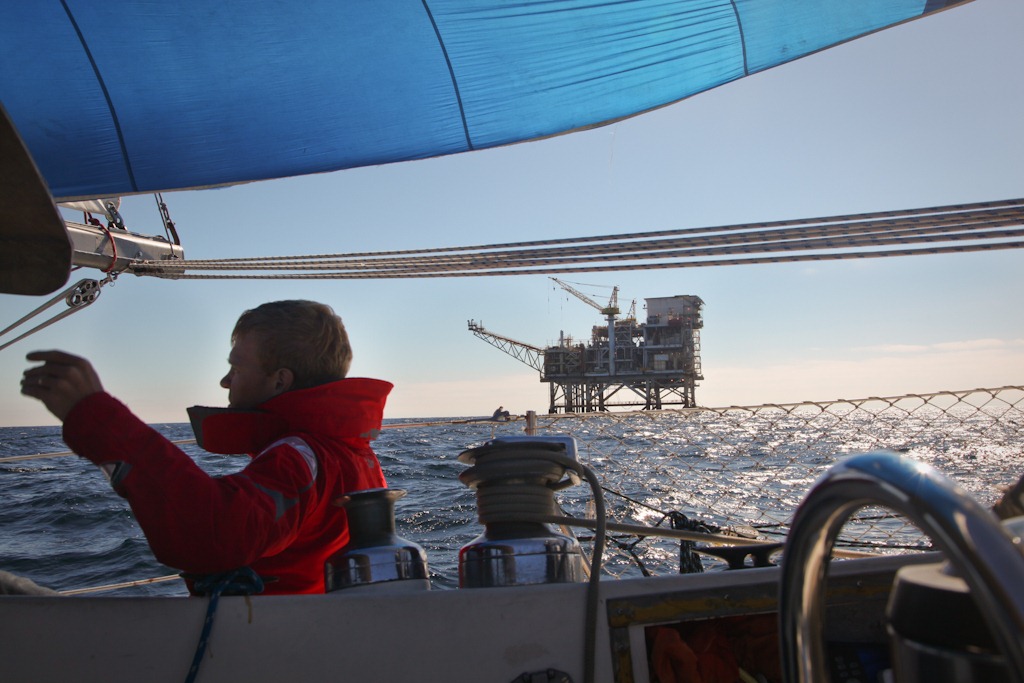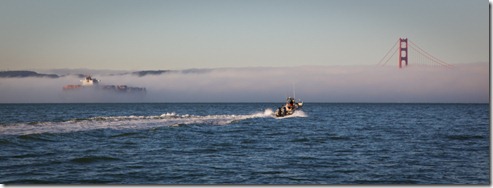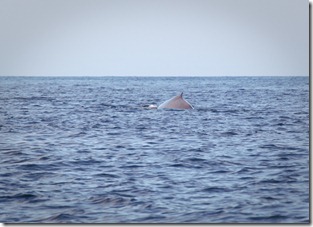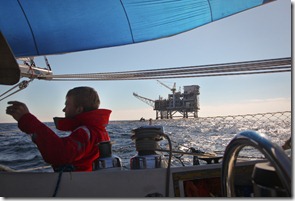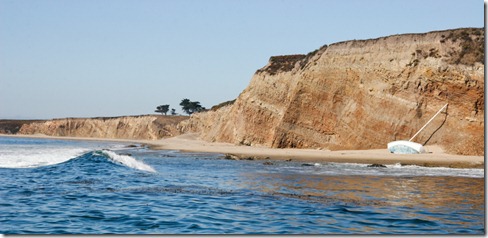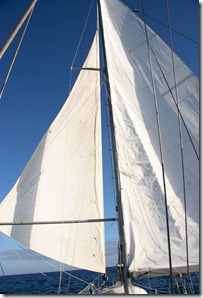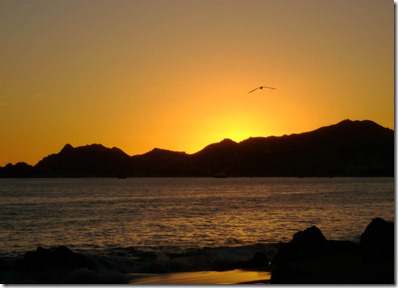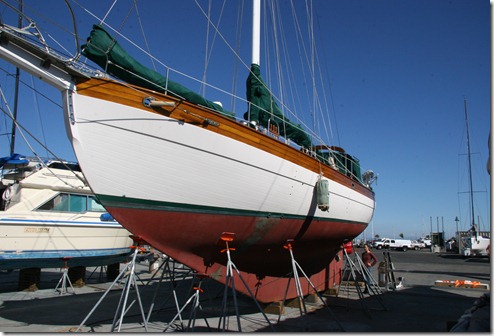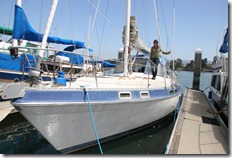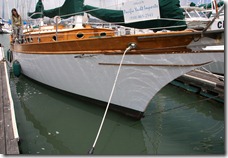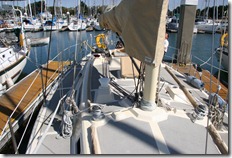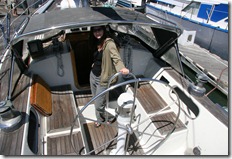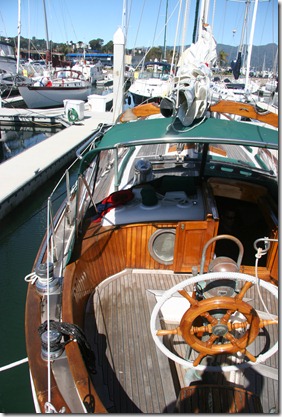September 15th-23rd, 2010
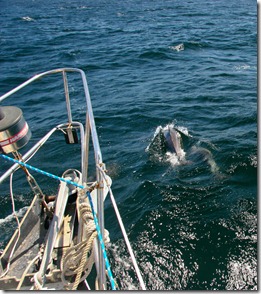 You really appreciate the little things when you’re on a sailboat; like sleeping in and having omelets for breakfast. I like being at sea, but I like it in the same way I like twenty mile hikes through the Texan desert: You get lots of time to introspect, it’s peaceful and often trance like, and when you finally reach your destination you feel an immense sense of accomplishment, not to mention your next hot cooked meal never tasted so good.
You really appreciate the little things when you’re on a sailboat; like sleeping in and having omelets for breakfast. I like being at sea, but I like it in the same way I like twenty mile hikes through the Texan desert: You get lots of time to introspect, it’s peaceful and often trance like, and when you finally reach your destination you feel an immense sense of accomplishment, not to mention your next hot cooked meal never tasted so good.
After breakfast at Cojo we weighed anchor and headed southeast towards the gap between Santa Rosa and Santa Cruz islands. We had decided to head straight to Santa Catalina to the south where we would spend some time in civilization at Avalon harbor before touring the local anchorages.
This leg of the trip was one of the most pleasant sailing portions. It was notably warmer than it had been. We were able to sail a good part of the time. We had numerous dolphin and porpoise sightings including large numbers of them riding our bow wave. The night was clear, and with the lights of the coast behind us the view of the stars and moon was stunning.
On the evening of the second day we reached Avalon, got tied to our mooring, and went to bed. The town of Avalon is an interesting little place. It is definitely a small town with a population of just over 3,000 people. It directly faces southern Los Angeles, and thanks to the ferry it is a popular day trip destination. That and the large number of boaters that visit the harbor make it a bit touristy, but getting off the beaten track isn’t too hard and the locals are quite amiable. The first thing we did when we arrived on shore was go get showers. There was a pay shower on the waterfront, and they were nice enough, although the attendant looked like he needed to avail himself of his own service. After that we had lunch, grocery shopped, visited the local coffee shop, and headed back to the boat for dinner.
The next day we motored up the coast to do some fishing. We had little success with the hook and line. When fishing for Rockfish, which are some of the more edible fish in the area, the strategy is to bounce a baited hook near rocky outcroppings where the fish hang out in small crevasses. Unfortunately we caught more rocks than rockfish. Spearfishing, on the other hand, was incredible. As you dive down below the canopy of broad kelp leaves, schools of small silvery fish part before you, their scales glinting in the beams of sunlight that filter through the fronds above.
 |
| 1Some Rights Reserved |
As you approach the stalks of the kelp forest, looking for an opening, everything goes dark all around you. It’s not until you’ve plunged in, unable to see more than a few feet ahead, that your eyes finally adjust and you see a new world of life. Larger fish glide warily around rocks covered in urchins, starfish, and sea grass. You must move slowly, spear extended, careful not to contact the rocks or kelp which would stir up sediment and alert the fish. And there you wait, ten feet down or more, for a fish to pass. Twitch even a little, or wait to long, and your prey will flee faster than you can hope to react or follow. Finally the moment is right and you relax your tight grip on the tensioned spear. It whooshes forward and lands home with a dull thud, the three prongs of the paralyzer tip disabling the fish and minimizing its thrashing. But now you must remain calm, to swim straight up in excitement would mean becoming hopelessly ensnared in the kelp, so you reverse your course, returning to the brilliant yellow green world outside the kelp.
My first catch was a medium sized Opaleye, which would turn out to be the easiest fish to catch, being almost as dumb and slow as the protected Garibaldi (state fish of California). It was large enough to fillet, and was decently tasty, but the more attractive Perch and the elusive Kelp Bass would become my prey later on as my skills improved. But then, to dull my pride, after we had boated my first catch, I dropped the spear in 70 feet of water before passing it to Jen.
 That night we anchored nearby at Buttonshell beach and headed back to Avalon the next morning. Bill and Monica took the ferry over to the mainland. Bill needed a boat part, and Monica was taking the train home (she had classes to get back for). Jen and I took a long walk through some of the less traveled parts of Avalon, and saw some great views of the town. We also replaced the spear I had lost with two new ones.
That night we anchored nearby at Buttonshell beach and headed back to Avalon the next morning. Bill and Monica took the ferry over to the mainland. Bill needed a boat part, and Monica was taking the train home (she had classes to get back for). Jen and I took a long walk through some of the less traveled parts of Avalon, and saw some great views of the town. We also replaced the spear I had lost with two new ones.
The next day we rounded the southern tip of the island and made another attempt at fishing along the rugged western coast. The western side of the island was exposed to quite a bit more swell and wind, which made the motion of the boat pretty uncomfortable,especially when we were drifting in an attempt to fish. Bill did catch a medium Scorpion Fish (a relative of the Rock Fish), but for Jen and I it was a bust again. That night we went to a place called little harbor. It was reputed to have a surf spot near by, but we didn’t see anything surfable.
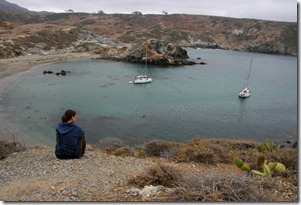 After the first night in Little Harbor we did some more spear fishing, with limited success. The water there was colder and murkier, and there seemed to be less sea life. We did, however, see some Bat Rays slide gracefully by along the sandy bottom. Although they’re generally harmless they made an intimidating spectacle. In the afternoon we went ashore in the dinghy, hiked around a bit, and generally enjoyed being on solid ground for a little while.
After the first night in Little Harbor we did some more spear fishing, with limited success. The water there was colder and murkier, and there seemed to be less sea life. We did, however, see some Bat Rays slide gracefully by along the sandy bottom. Although they’re generally harmless they made an intimidating spectacle. In the afternoon we went ashore in the dinghy, hiked around a bit, and generally enjoyed being on solid ground for a little while.
The following day, after two nights in Little Harbor we set out again to return to the east side of the island, where we spent another night at Buttonshell, and did some more fishing. From there it was on to Santa Cruz island…
Coming Soon:
- Part 3. Santa Cruz Island
- Part 4. The Trip Home
The image “Kelp Forest” by David Ciani reused with modification under the Creative Commons Noncommercial-Attribution-Share Alike License



